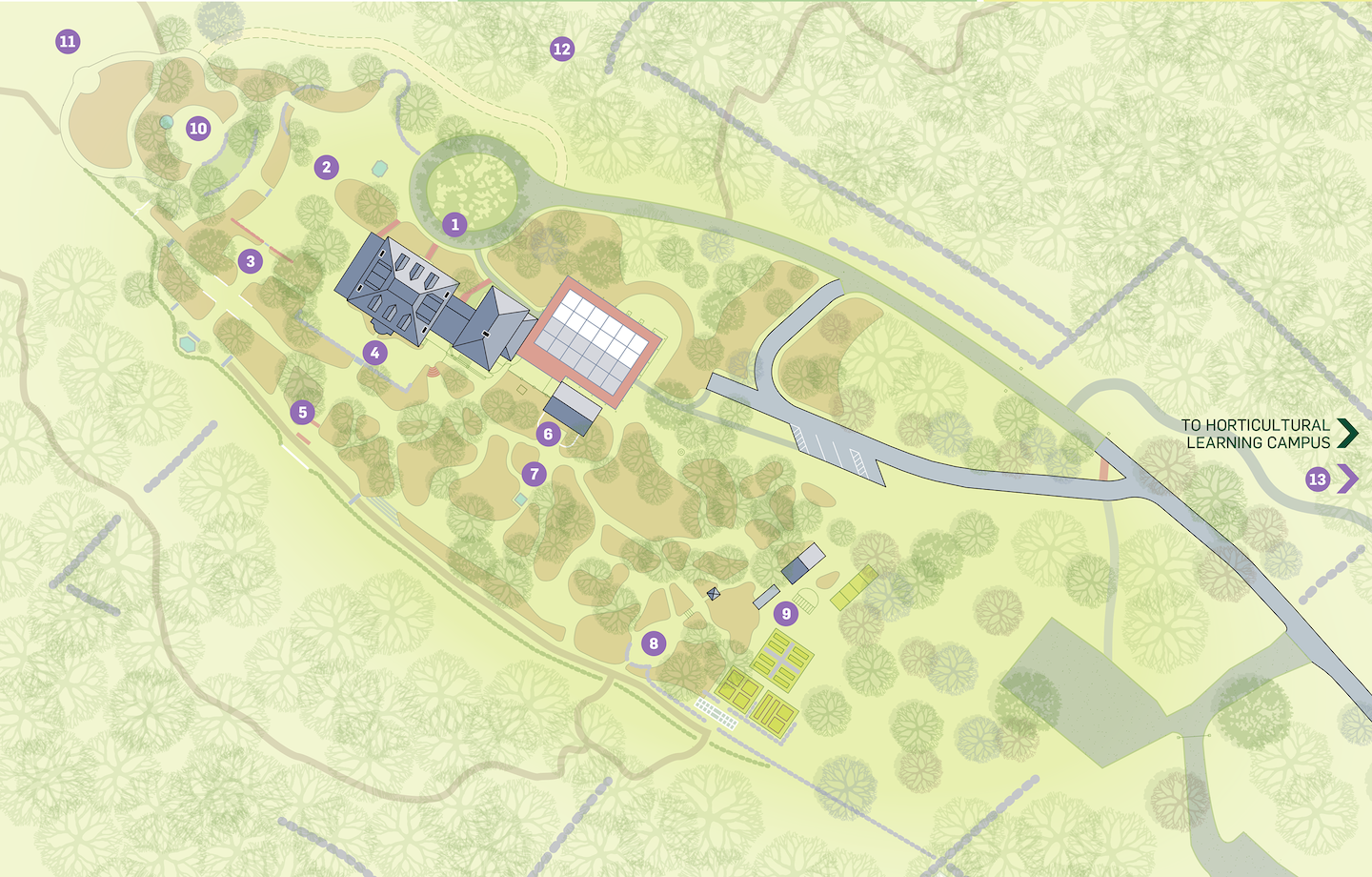
House Entrance
This area of the property is most famous for the large Copper Beech tree that is situated in front of the house. The stately and welcoming Fagus sylvatica ‘Atropunicea’ was planted in 1917, before the Main House was built, in front of the predetermined site of the front door.
Croquet Lawn
At the north end of this expansive lawn sits ‘Mount Sam’. Accented by its French ironwork pavilion, Mount Sam offers a commanding view to the south over the Croquet Lawn lotus pool, and countryside beyond. Native Juniperus virginiana (eastern redcedar) are skillfully integrated to create a framework of walls and passages and to provide textural contrast.
Little Garden
Separated from the Croquet Lawn by metal arches design to support clematis, this classical garden room contains a 19th-century Chinese gate leading to the Main Terrace and four Chinese tile fences located as you exit towards the south lotus pool. In this pool, visitors can see Nelumbium species (Egyptian lotus), which produce unique flowers, creating a dramatic display in August. The path to the pool is flanked by a small, gray-foliage garden and a miniature Buxus microphylla ‘Kingsville Dwarf’ (boxwood) hedge.
House Terrace
Skillful manipulation of plantings enhances the vista from this terrace. Wisteria floribunda (Japanese wisteria), Schizophragma hydrangeoides (Japanese hydrangea-vine), Campsis radicans (trumpet vine), and Clematis recta (shrub clematis) complement the grand bowed back entrance to the house. Also nearby are a set of fan steps, which are topped by the barn’s old millstone. These steps were installed in 1945 at the suggestion of noted landscape architect Fletcher Steele. The massive weeping Tsuga canadensis ‘Pendula’ (weeping Canadian hemlock) complements the weeping cherries nearby.
South Vista
Skillful manipulation of plantings enhances the vista from this terrace. Wisteria floribunda (Japanese wisteria), Schizophragma hydrangeoides (Japanese hydrangea-vine), Campsis radicans (trumpet vine), and Clematis recta (shrub clematis) complement the grand bowed back entrance to the house. Also nearby are a set of fan steps, which are topped by the barn’s old millstone. These steps were installed in 1945 at the suggestion of noted landscape architect Fletcher Steele. The massive weeping Tsuga canadensis ‘Pendula’ (weeping Canadian hemlock) complements the weeping cherries nearby.
Carriage House Garden
The balustrade here encloses a collection of Paeonia suffruticosa (tree peony) and clematis. Neo-classical architectural details on the structure, built in 1926, are copied from a Salem coach house. Antique lavender-colored “bull’s-eye” window glass is believed to have been a gift from interior designer Henry Davis Sleeper of Beauport, Gloucester.
Woodland Garden
A notable magnolia collection and the exotic Sciadopitys verticillata (Japanese umbrella-pine) are situated along these paths. There is also a woodland pool, filled with water lilies and surrounded by ornamental trees, including Magnolia virginiana (sweetbay magnolia), as well as Stewartia ovata (mountain stewartia) and Stewartia monadelpha (tall stewartia), both rare in the region’s gardens. Tall stewartia has a lovely bark patterned in red, gray, and brown.
Horseshoe Garden
This garden displays a collection of hybrid species of azaleas and masses of spring bulbs. The southern view from the Chinese Pagoda leads through a wrought iron gate to a Cornus kousa (kousa dogwood) beyond. Until 1924, the pagoda stood as a wellhead on a Beverly farm. Standing on the slope above the Horseshoe Garden is a bronze crane made by Marblehead sculptor Beverly Seamans.
Cutting Garden
This was one of the first areas Mabel Sedgwick developed at Long Hill. She used it to propagate plants for her gardens. Later, Marjorie Sedgwick created distinctive arrangements with flowers from this garden. Outfitted with compost bins, cold frames, and a potting shed, this area continues to be used as a workspace. At the south end of this area is the Rose Arbor. Built in 1927, this elegant arbor guides one past an Albizia julibrissin (mimosa tree) and two handsome specimens from China: Metasequoia glyptostroboides (dawn redwood), a decidious conifer, and the Davidia involucrata (handkerchief tree), which bears striking white bracts in mid-May.
Summer Garden
The Summer Garden is a contemporary extension of the historic gardens reflecting their gentle curves, sweeps of perennials, and layers of trees, shrubs, and spring blooming bulbs. Though beautiful in all seasons, this garden emphasizes the splendor of summer with seasonally blooming plants in shades of cream, pink, burgundy, lavender, and blues. A reflecting pool provides a quiet spot for reflection and native junipers provide shade and structure. The garden is set against the backdrop of a native plant meadow.
Meadow
The Meadow was carved out of a post-agricultural woodland with an understory dominated by invasive shrubs. Seeded with native grasses and flowering perennials which provide resources for pollinators and other wildlife, the meadow is punctuated with upright Eastern red cedar (Juniperus virginiana ‘Taylor’) reminiscent of the young cedars that grew in the fields and meadows when the Sedgwick’s arrived in 1916. These cedars provide perching and nesting sites, as well as food for birds who visit the meadow. Paths through the meadow allow for quiet observation and connect to the woodland paths.
North Vista
This glimpse of sky through the opening in the forest, with its low swaths of native plants, was carefully maintained by Mabel and Marjorie Sedgwick as a reminder that the garden is positioned on the top of a hill.
Discovery Garden
The Discovery Garden is a place for visitors of all ages to explore, play, and learn more about plants.
Horticultural Learning Campus
Long Hill is a focal point for horticultural and gardening education within The Trustees and the North Shore community. We've always considered the grounds of Long Hill to be one large outdoor learning laboratory. The Horticultural Learning Campus, built in 2022, features the Nancy and George Putnam Learning Center, along with a greenhouse and potting shed and workshop, which have dramatically increased our capacity to convene a wide range of programming and educational opportunities for all ages and levels of expertise.